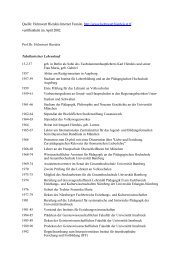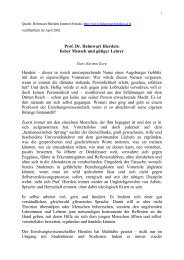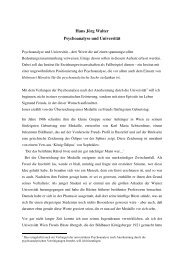Download pdf - Universität Innsbruck
Download pdf - Universität Innsbruck
Download pdf - Universität Innsbruck
Erfolgreiche ePaper selbst erstellen
Machen Sie aus Ihren PDF Publikationen ein blätterbares Flipbook mit unserer einzigartigen Google optimierten e-Paper Software.
94 Sebastian Sevignani<br />
2.2 Privacy<br />
The starting point of the modern privacy debate was an article by Samuel D. Warren and<br />
Louis D. Brandeis published in 1890. The motive to write this article was an infringement<br />
during the wedding of Warren´s daughter by the press. In this article, privacy is defined as<br />
the “right to be left alone” (Warren & Brandeis, 1984, p. 76). “The right to be left alone” is<br />
identical with the liberal core value of negative freedom (see Rössler, 2001, p. 20–21), and<br />
as such it determines most of the subsequent theoretical work on privacy and situates it<br />
within this liberal tradition. If privacy is related to the values of autonomy (see Fried,<br />
1968; Rachels, 1975; Reiman, 1976; Altman, 1976; Gavinson, 1984; Rössler, 2001; Bennett<br />
& Raab, 2006) and freedom (see Warren & Brandeis, 1984; Westin, 1967) on the individual<br />
level, then it is mainly understood as autonomy from society, autonomy to<br />
choose, and freedom from intrusion by the state and society. The notion of individual privacy<br />
influences the notion of privacy on other levels. On the interpersonal level, when<br />
authors speak about intimacy (see Westin, 1967) and other social relationships, what is<br />
meant is the ability to engage in contract relations. They assume that an individual is enabled<br />
by privacy to enter relationships with others. Social relations and the role of privacy<br />
therein have a derived status; derived from the individual level. Many approaches that<br />
stress the value of privacy concerning societal aims (see Regan, 1995; Westin, 2003), such<br />
as wealth, democracy, freedom of speech, freedom of polls, freedom of opinion, difference,<br />
and pluralism, also based their understanding on an individualistic notion of privacy.<br />
Therefore, all these approaches have a limited notion of societal issues. Most of the privacy<br />
literature stresses the value of privacy for individuation one-sided.<br />
Today (informational) privacy is most often defined either as control over flows of information<br />
or over the access to information. For Alan F. Westin “privacy is the claim of individuals,<br />
groups, or institutions to determine for themselves when, how, and to what extent<br />
information about them is communicated to others” (Westin, 1967, p. 7). Westin focuses<br />
on the control of information, which makes him a prototypical proponent of “control-theories”<br />
of privacy (see Tavani, 2008, pp. 142–143). On the other hand, there are “access-theories”<br />
of privacy (see Tavani, 2008, pp. 141–142). For Gavinson privacy “is related to our<br />
concern over our accessibility to others: the extent to which we are known to others, the<br />
extent to which others have physical access to us, and the extent to which we are the subject<br />
of others' attention” (Gavinson, 1984, p. 347). If we combine these two major strands<br />
of privacy approaches one can speak about privacy as the individual control over the access<br />
to personal information (see Tavani 2008). Some authors (see Wacks, 2010, pp.40–<br />
41; Solove, 2008, p. 25) challenge the in-determination of “privacy as control” definitions;<br />
they argue that these theories do not discuss what specific privacy subjects they refer to.<br />
Control theories fail to define the content of privacy. In fact, it is the “freedom to choose<br />
privacy” (Wacks, 2010, p. 41) and not a determination of the content of privacy that control<br />
theories deal with. Here, privacy is what is subjectively seen as privacy; such theories,<br />
therefore, foster individuals’ exclusive control over their data, and do not want to and can-
















